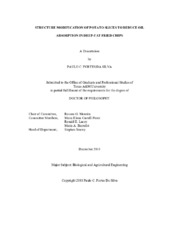| dc.description.abstract | A consumer demand for healthier snacks has stimulated the scientific work on the issues of fat uptake on fried products. Most of oil absorption is a surface-controlled phenomenon, taking place when the product’s structure is formed at the end of frying.
The first part of this study focused on evaluating different pre-treatments (soaking, dehydration, enzyme activation, sonication) associated with the calcium (Ca^+2) ion impregnation in potato tissue to enhance cellular-structure integrity during frying and its effects on oil absorption. The highest oil-content reductions were: 26.5% for “soaking” in CaClv2 (20000 ppm / 30 min), 19% for “dehydration” in ethanol (70% v/v) + CaClv2 (10000 ppm) for 2 minutes, 8.8% for “thermal treated” (50.0ºC/30min) + CaClv2 (10000 ppm), 14.9% for “sonicated-assisted thermal treated” (50.0ºC/30min) + CaClv2 (10000 ppm), and 30.2% for “sonicated-assisted soaking” in CaClv2 (20000 ppm / 30 min).
The second part focused on optimization of ultrasound wave parameters to effectively delivery Ca^+2 ions to the potato slices tissue as a pre-treatment to minimize oil absorption. At the maximum soaking CaClv2 concentrations (50x10^3 ppm) and the longest time (30 min), sonicated samples showed a decrease of 43% in oil content when compared to the control.
The response surface methodology study estimated an oil content of 0.21 kg oil/kg DM for potatoes pre-treated in a CaClv2 (50.0 x10^3 ppm) solution for 16.5 minutes
(non-sonicated), and 0.16 kg oil/kg DM in a CaClv2 (50.0 x10^3 ppm) solution for 23 minutes (sonicated).
Sonication made samples whiter in color (L*) and tougher to brake than the controls. Higher CaCl2 concentrations yielded darker samples, higher bulk and solid densities, and higher degree of shrinkage for S/NS samples than the control ones.
Sensory evaluation of the control, non-sonicated, and sonicated samples found that the sensory quality attributes of “texture”, “flavor”, and “overall quality” were statistically significant (p < 0.05) among the treatments. The “sonicated” treatment scored the highest values for texture, flavor, and overall quality.
Sonication with calcium (Ca^+2) ion impregnation of potato tissue was effective in reducing the oil absorption of potato chips during deep-fat frying. | en |


